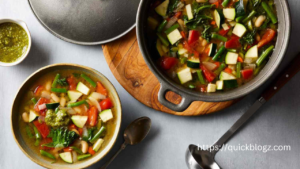How to Make Flavour in my vegetable soup?
The last time I ordered soup in a restaurant was—well, let me see—possibly never. That’s because in my mind, soup is something to be made and eaten at home, ideally with a cuddly animal at your feet in front of a blazing fireplace while the wind whips outside. How to Make Flavour in my vegetable soup?
The soup I’m talking about is never bland or thin; it’s hearty, warming, and nourishing. I’m talking about transforming chicken wings into a full-bodied, deep-amber stock. I’m talking about quietly coaxing cauliflower into a lush purée—no cream required. Most of these techniques take some time, so set aside a lazy afternoon to let soup do its thing, melding disparate flavors into a cohesive whole. You’ll be rewarded with a bowl of soup that’s far more than a first course: It’s satisfying enough to be called dinner. —Claire Saffitz
Here’s how to make soup taste better—as in, more flavorful and more robust—in 13 steps.
1. Stock can be simple.
If a building is only as strong as its foundation, a soup is only as good as its broth. Begin with something that tastes great on its own, homemade or store-bought, and you’re well on your way. How to Make Flavour in my vegetable soup?

While many wonderful stocks are built around a roster of ingredients, from bones and dried seafood to spices, veg scraps, and cheese rinds, the pot needn’t always be a full house! You can extract a clean, strong broth from a combination of water and several pantry ingredients. It’s all about layering powerful flavor-enhancers that you probably already have on hand—bacon, tomato paste, herbs, peppercorns, a Parmesan rind, and, of course, kosher salt.
2. It’s all about that base.
Whether you’re starting with a classic combo—sofrito, mirepoix, the Cajun trinity of onion, green bell pepper, and celery—or just a mishmash of vegetables from your fridge, these aromatics will infuse the whole pot. Sweat them slowly and gently for sweetness, or brown them deeply for a toastier, more savory backbone.
3. Sear before you simmer.
Browning your ingredients on the stovetop or in the oven creates deep, savory flavors that you won’t get from simply adding those same ingredients straight to a pot of water.
Take our Double-Dark Chicken Noodle Soup recipe, for example. By browning the wings on the stovetop, you caramelize all of their nooks and crannies, which, in turn, imbues the stock with flavor.
To achieve a similar goal but keep your hands (and stove) free, consider the oven: For the most savory meat stock, begin by browning the bones (and the veg too!) on a sheet pan. Or bake a halved winter squash, then discard the seeds, scoop out the flesh, and blend with broth. Or, for the tomatoiest tomato soup possible, start by roasting canned whole tomatoes until jammy in order to intensify their umami underpinnings. If you’re tired of babysitting dried beans, bring them to a simmer on the stove, then cover the pot and stick it in a 300° oven: The gentle all-around heat will cook them to tender perfection.
4. Season as you go.
Adding unseasoned ingredients to seasoned ones makes your mixture bland. This is why it’s imperative to add salt not just when the dish is complete but at every stage of the process. Sweating aromatics? Season them. Adding more stock? Salt it. Tossing a bunch of veg into the pot? You get the point. Taste constantly and adjust as you go—you’ll be amazed at the intensity that comes through when you nail it.
5. For silky purées, sweat your vegetables.

Simmering vegetables in a covered pot over low heat so that they steam in their own liquid—a French technique called à l’étouffée—is the ticket to achieving a soup with pronounced depth. We love this method with cauliflower, but also try it with celeriac or rutabagas. How to Make Flavour in my vegetable soup?
6. Make it creamy—without cream.
It’s possible to replicate the silky richness of cream without drizzling in dairy—and to add even more flavor along the way. Blend in a big spoonful of nut or seed butter (peanut, almond, cashew, tahini), cooked beans, or a scoop of hummus. Or incorporate a peeled, boiled potato, cubes of crustless bread, or steamed or roasted cauliflower. If you’re not excited by puréed soup but you still crave creaminess, cook rice or barley in the stock for a porridge-like consistency, thicken it with a chickpea flour slurry, or mix in coconut milk or coconut cream for heat-cutting sweetness.
7. Do some textural troubleshooting.
When making any puréed soup, don’t blend all the liquids and solids together at once. Hold back some liquid at first and use it to thin the soup as needed. You can always add more liquid, but there’s not much you can do to fix a too-thin soup.
8. Make that egg drop.
From Chinese American egg drop to Roman stracciatella, some of the world’s great soups are finished with egg for added substance, richness, and flavor. Start with any brothy soup, then follow chef Lucas Sin’s lead. How to Make Flavour in my vegetable soup?
9. When soup feels flat, pull out your tool kit.
When the soup’s not quite right, try these fixes. Test them out with a little ladleful in a separate bowl before scaling up to the whole pot:

- Salt: If you began with unsalted broth, this is the first remedy to try. Remember, you’re seasoning a lot of water and a lot of food! Salt gradually but generously, tasting often and keeping in mind any salty toppings.
- Acid: A final squeeze of citrus or a little splash of vinegar brightens almost any bowl —it’s especially important if your soup doesn’t have a built-in acid source (like tomatoes, wine, black lime, kimchi, pickles, or greens).
- Sugar: A pinch of sugar softens the edges of anything that tastes too sour or harsh (looking at you, tomato-based soups).
10. Don’t skip the toppings.
To take soup from starter to supper, from snack to substance, have fun with what goes on top. Try adding…
- A diced grilled cheese sandwich
- Tadka with ghee, dried red chiles, cumin seeds, and asafetida
- A spoonful of salted plain yogurt
- The last crumbs from the bottom of any chip bag
- Pan-crisped cubes of Halloumi cheese or paneer
- Swirls of pesto or brown butter
- A pile of lime-dressed shredded cabbage
- Crispy fried garlic chips or shallot rings
- A soft-cooked egg, broken open
1. Heat your bowls.
Ladling hot soup into cold bowls will chill it slightly. Simple preventive measure? Preheat your oven to its lowest temperature (usually around 200°). Turn off the oven, place soup bowls inside, and allow them to warm up for 10 minutes.
12. Save some for later.
Even soups that aren’t make-on-a-Monday-night candidates can still be weeknight staples. Many soups improve the next day and freeze well (freeze noodles or pasta separately!). To reheat, thaw overnight in the refrigerator, then slowly bring the soup up to temp in a covered pot over medium heat, stirring often and scraping the bottom of the pot with a wooden spoon.
13. Or start with leftovers in the first place.
With the addition of broth, nearly any vexing leftover can become soup. A bit of broth can turn cooked beans—plus olive oil, canned tomatoes, and a handful of ditalini— into pasta e fagioli. It can transform caramelized onions into imitation French onion soup (add cheesy toast), and it can reshape cooked grains, sautéed greens, and roast chicken into a makeshift pot of comforting chicken and rice. Hey, with a little broth, even last night’s pasta with meatballs can emerge as tonight’s tomato soup with noodles.



